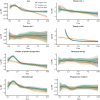Multiple imputation in Cox regression when there are time-varying effects of covariates
- PMID: 30014575
- PMCID: PMC6220767
- DOI: 10.1002/sim.7842
Multiple imputation in Cox regression when there are time-varying effects of covariates
Abstract
In Cox regression, it is important to test the proportional hazards assumption and sometimes of interest in itself to study time-varying effects (TVEs) of covariates. TVEs can be investigated with log hazard ratios modelled as a function of time. Missing data on covariates are common and multiple imputation is a popular approach to handling this to avoid the potential bias and efficiency loss resulting from a "complete-case" analysis. Two multiple imputation methods have been proposed for when the substantive model is a Cox proportional hazards regression: an approximate method (Imputing missing covariate values for the Cox model in Statistics in Medicine (2009) by White and Royston) and a substantive-model-compatible method (Multiple imputation of covariates by fully conditional specification: accommodating the substantive model in Statistical Methods in Medical Research (2015) by Bartlett et al). At present, neither accommodates TVEs of covariates. We extend them to do so for a general form for the TVEs and give specific details for TVEs modelled using restricted cubic splines. Simulation studies assess the performance of the methods under several underlying shapes for TVEs. Our proposed methods give approximately unbiased TVE estimates for binary covariates with missing data, but for continuous covariates, the substantive-model-compatible method performs better. The methods also give approximately correct type I errors in the test for proportional hazards when there is no TVE and gain power to detect TVEs relative to complete-case analysis. Ignoring TVEs at the imputation stage results in biased TVE estimates, incorrect type I errors, and substantial loss of power in detecting TVEs. We also propose a multivariable TVE model selection algorithm. The methods are illustrated using data from the Rotterdam Breast Cancer Study. R code is provided.
Keywords: Cox regression; missing data; multiple imputation; restricted cubic spline; time-varying effect.
© 2018 The Authors. Statistics in Medicine Published by John Wiley & Sons Ltd.
Figures





Similar articles
-
Dealing with missing information on covariates for excess mortality hazard regression models - Making the imputation model compatible with the substantive model.Stat Methods Med Res. 2021 Oct;30(10):2256-2268. doi: 10.1177/09622802211031615. Epub 2021 Sep 2. Stat Methods Med Res. 2021. PMID: 34473604
-
Cox regression analysis with missing covariates via nonparametric multiple imputation.Stat Methods Med Res. 2019 Jun;28(6):1676-1688. doi: 10.1177/0962280218772592. Epub 2018 May 2. Stat Methods Med Res. 2019. PMID: 29717943 Free PMC article.
-
Multiple imputation of covariates by fully conditional specification: Accommodating the substantive model.Stat Methods Med Res. 2015 Aug;24(4):462-87. doi: 10.1177/0962280214521348. Epub 2014 Feb 12. Stat Methods Med Res. 2015. PMID: 24525487 Free PMC article.
-
How are missing data in covariates handled in observational time-to-event studies in oncology? A systematic review.BMC Med Res Methodol. 2020 May 29;20(1):134. doi: 10.1186/s12874-020-01018-7. BMC Med Res Methodol. 2020. PMID: 32471366 Free PMC article.
-
Folic acid supplementation and malaria susceptibility and severity among people taking antifolate antimalarial drugs in endemic areas.Cochrane Database Syst Rev. 2022 Feb 1;2(2022):CD014217. doi: 10.1002/14651858.CD014217. Cochrane Database Syst Rev. 2022. PMID: 36321557 Free PMC article.
Cited by
-
Methods for Employing Information About Uncertainty of Ascertainment of Events in Clinical Trials.Ther Innov Regul Sci. 2021 Jan;55(1):197-211. doi: 10.1007/s43441-020-00206-3. Epub 2020 Sep 1. Ther Innov Regul Sci. 2021. PMID: 32870460
-
Using information criteria to select smoothing parameters when analyzing survival data with time-varying coefficient hazard models.Stat Methods Med Res. 2023 Sep;32(9):1664-1679. doi: 10.1177/09622802231181471. Epub 2023 Jul 5. Stat Methods Med Res. 2023. PMID: 37408385 Free PMC article.
-
Reference-based sensitivity analysis for time-to-event data.Pharm Stat. 2019 Nov;18(6):645-658. doi: 10.1002/pst.1954. Epub 2019 Jul 15. Pharm Stat. 2019. PMID: 31309730 Free PMC article.
-
Using simulation studies to evaluate statistical methods.Stat Med. 2019 May 20;38(11):2074-2102. doi: 10.1002/sim.8086. Epub 2019 Jan 16. Stat Med. 2019. PMID: 30652356 Free PMC article.
-
Association between Abortion and All-Cause and Cause-Specific Premature Mortality: A Prospective Cohort Study from the UK Biobank.Health Data Sci. 2024 Jul 15;4:0147. doi: 10.34133/hds.0147. eCollection 2024. Health Data Sci. 2024. PMID: 39011272 Free PMC article.
References
-
- Cox DR. Regression models and life tables. J R Stat Soc Ser B. 1972;34(2):187‐202.
-
- Cox DR. Partial likelihood. Biometrika. 1975;62(2):269‐276.
-
- Rubin DB. Multiple Imputation for Nonresponse in Surveys. Hoboken, NJ: John Wiley & Sons; 1987.
-
- Carpenter JR, Kenward MG. Multiple Imputation and its Application. Chichester, UK: John Wiley & Sons; 2013.
Publication types
MeSH terms
Grants and funding
LinkOut - more resources
Full Text Sources
Other Literature Sources
